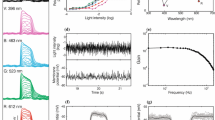Abstract
A critical examination of the “classical” theories of photoreception in view of more recent experimental findings yields the result that these theories do not possess the property to describe all the more significant phenomena of photoreception correctly, and to some extent suffer the lack of more general applicability. The basis for a new and presumably more general theory of photoreception based on dynamical aspects is laid out. Emphasis is put on the time course of afferent and efferent excitation in the photoreception model, consisting of a receptor element, an afferent and an efferent neuron of the one-factor Rashevsky-type, and an effector organ.
Similar content being viewed by others
Literature
Granit, R. and H. A. Riddell. 1934. “The Electrical Responses of Light and Dark Adapted Frog's Eyes to Rhythmic and Continuous Stimuli.”Jour. Physiol.,81, 1–28.
Hecht, S. 1931. “Die physikalische Chemie und die Physiologie des Sehaktes.”Erg. Physiol.,32, 243–390.
— 1934. “A Theoretical Basis for Intensity Discrimination in Vision.”Proc. Nat. Acad Sci.,20, 644–55.
Rashevsky, N. 1948.Mathematical Biophysics. Rev. Ed. Chicago: University of Chicago Press.
Runge, R. 1945. “A Theory of Photosensitivity of Some Lower Animals.”Bull. Math. Biophysics,7, 59–67.
Author information
Authors and Affiliations
Rights and permissions
About this article
Cite this article
Wette, R. Outlines of a new theory of photoreception. Bulletin of Mathematical Biophysics 15, 251–260 (1953). https://doi.org/10.1007/BF02476401
Received:
Issue Date:
DOI: https://doi.org/10.1007/BF02476401




